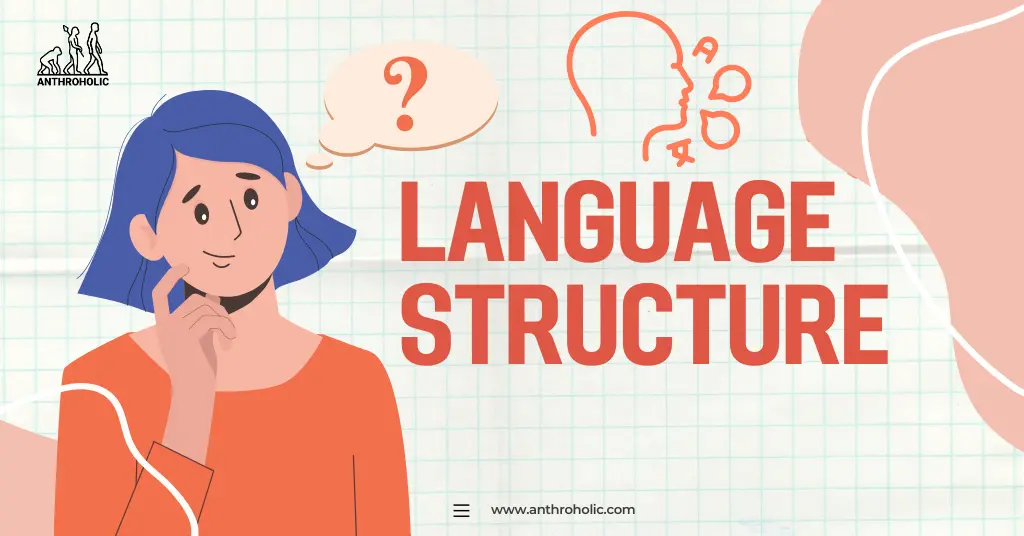AI Answer Evaluation Platform Live Now. Try Free Answer Evaluation Now
Language Structure
Language is one of the most salient aspects of human societies, acting as a mirror of cultural and social phenomena [1]. Anthropologists explore language structures not just as systems of symbols, but as a tool shaping human cognition and social interaction.

Phonology: The Sound System
Phonology, the study of the organization of sounds in languages, is an integral part of language structure. From an anthropological perspective, phonology offers insights into cultural identity and the historical development of languages.
- Distinctive Features: Distinctive features refer to the physical characteristics of sound, such as voicing, place, and manner of articulation [2]. These features differentiate meaning among languages, underscoring their symbolic nature.
- Phonemes and Allophones: Phonemes are the smallest units of sound that can distinguish meaning, while allophones are variants of phonemes that do not change meaning [2].
Morphology: The Structure of Words
Morphology is concerned with how words are formed and their internal structure, offering critical insights into the social context and historical changes.
- Morphemes: Morphemes are the smallest meaningful units of language. They can be either free (can stand alone as words) or bound (must be attached to other morphemes) [3].
- Word Formation Processes: Words are formed through various processes, such as compounding, affixation, and reduplication, reflecting cultural norms and cognitive processes [4].
Syntax: The Structure of Sentences
Syntax, the study of sentence structure, reveals a lot about cognitive processes and cultural paradigms [5].
- Phrase Structure Rules: These rules, which vary among languages, dictate how words and phrases can be combined.
- Syntactic Categories: Different languages categorize words differently, revealing cultural and cognitive differences [5].
Semantics: The Meaning of Words and Sentences
Semantics is the study of meaning in language. It can provide information about societal values, cultural norms, and ways of thinking [6].
- Lexical Semantics: This deals with word meaning and the relationships between words, such as synonyms, antonyms, and homonyms.
- Phrasal Semantics: This examines how the meaning of phrases and sentences is constructed from individual words [6].
The Interaction of Components
While each of these components can be studied separately, their true value lies in their interaction. Together, they construct a complex system of human communication, influencing and influenced by cultural norms and societal structures.
Table 1 below illustrates this interaction with examples:
| Component | Example |
|---|---|
| Phonology | The difference in sound between the English words “bit” and “beat” distinguishes their meanings |
| Morphology | In English, adding the suffix “-ed” to the verb “play” changes its tense to past (“played”) |
| Syntax | The sentence “The cat chases the mouse” has a different meaning than “The mouse chases the cat” |
| Semantics | The word “freedom” carries different connotations in different cultural contexts |
Pragmatics: The Study of Context
Pragmatics, the study of how context influences language interpretation, is crucial to anthropological studies of language. It provides a deeper understanding of how language structure is used in real-world situations.
- Deixis: Deixis refers to words and phrases whose interpretation depends on the context of the utterance, like “here”, “there”, “this”, “that”, etc.
- Speech Acts: This concept illustrates how language can be used to perform actions, such as requests, commands, promises, and apologies, demonstrating the link between language and social behavior.
Sociolinguistics: Language in Society
Sociolinguistics examines the relationship between language and society, providing insights into social structures, norms, and values.
- Language Variation: Language varies based on social factors such as region, social class, age, and gender. This variation manifests in different accents, dialects, and even languages.
- Language Change: Over time, languages change due to cultural shifts, contact with other languages, and technological advancements. These changes are evident in phonology, morphology, syntax, and semantics.
Anthropological Approaches to Language Structure
Anthropologists use various research methods to study language structure:
- Participant Observation: Anthropologists immerse themselves in the community they are studying to understand the social context of language use.
- Ethnography: This involves detailed descriptions of people’s language use in their cultural context.
- Comparative Studies: These compare language structures across different cultures to identify patterns and differences.
- Historical Linguistics: This approach studies language change over time, tracing the origins and evolution of languages.
Implications of Language Structure Research
Language structure research has important implications for various domains:
- Education: Linguistic anthropology can aid language teaching and learning, fostering cross-cultural understanding.
- Policy Making: Research findings can inform language policy and planning, contributing to social equity.
- Technology: Understanding of language structure can improve machine learning algorithms, enhancing artificial intelligence and natural language processing applications.
Conclusion
Studying language structure through an anthropological lens reveals the intricate interplay between language, cognition, and culture. The different aspects of language structure—phonology, morphology, syntax, semantics, pragmatics, and sociolinguistics—interact dynamically to facilitate human communication. Through participant observation, ethnography, comparative studies, and historical linguistics, anthropologists provide rich insights into this complex system, contributing to a broad range of domains from education to technology.
References
[1] Duranti, A. (1997). Linguistic Anthropology. Cambridge University Press.
[2] Hyman, L. M. (1975). Phonology: Theory and Analysis. Holt, Rinehart and Winston.
[3] Aronoff, M., & Fudeman, K. (2005). What is Morphology?. Blackwell Publishing.
[4] Spencer, A., & Zwicky, A. M. (1998). The Handbook of Morphology. Blackwell Publishers.
[5] Carnie, A. (2013). Syntax: A Generative Introduction. Wiley-Blackwell.
[6] Cruse, D. A. (1986). Lexical Semantics. Cambridge University Press.




